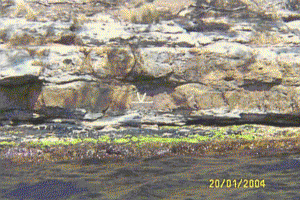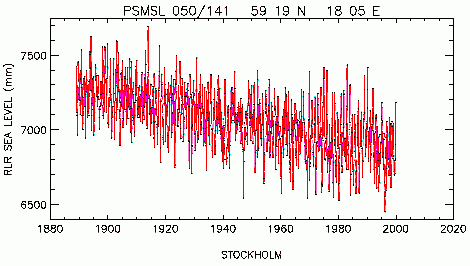wow(according to that 'news' opinion) in a century (100 years) it will go up a total of 8 inches
the sea level is the same as it was 150 years ago
the sealevel is nearly the same as it was in 1842
...infact it is BELOW the sealevel mark made in 1842
In 1842 the "Isle of the Dead" in SE Tasmania was selected for the site of a "Mean Sea Level" refernce mark by Capt. James Clark Ross. Today this mark can clearly be seen 35 cm ABOVE the current mean sea level.
For a wonderful examination of Sea Level change from 1841 to 2004, this picture is worth a thousand words:

Here is another view — this time, the mark has been traced over with line to emphasize it

The 1841 sea level benchmark (centre) on the ‘Isle of the Dead’, Tasmania. According to Antarctic explorer, Capt. Sir James Clark Ross, it marked mean sea level in 1841. Photo taken at low tide 20 Jan 2004. Mark is 50 cm across; tidal range is less than a metre.
Let’s read that again and consider four things:
#1) - the mark was placed at mean sea level. The word “mean” in this use denotes the “mathematical average”. The sea rose above it and set below it by an equal amount during the tidal cycle.
#2) - The mark was made in the middle of the tidal range in 1841 and it was photographed 163 years later at the bottom of the tidal cycle.
#3) - the tidal cycle is one meter and the mark is 50 centimeters or one-half meter long.
#4) - the mark is sitting about 30 or 40 centimeters above the water in the photograph. Given that there is some wave surge, it looks like the level of the ocean has not changed one bit in 163 years.
and here sealevels monitored in Stockholm

and lets not forget that sealevel rate changes all the time

oh and lets not forget that the 'land' is on MOVING TECTONIC plates.....and Mean sea level is not constant over the surface of the Earth. For instance, mean sea level at the Pacific end of the Panama Canal stands 20 cm (7.9 in) higher than at the Atlantic end.
Over most of geologic time, long-term sea level has been higher than today (see graph above). Only at the Permian-Triassic boundary ~250 million years ago was long-term sea level lower than today. Long term changes in sea level are the result of changes in the oceanic crust, with a downward trend expected to continue in the very long term.
During the glacial/interglacial cycles
over the past few million years, sea level has varied by somewhat more than a hundred metres. This is primarily due to the growth and decay of ice sheets (mostly in the northern hemisphere) with water evaporated from the sea.
The Mediterranean Basin's gradual growth as the Neotethys basin, begun in the Jurassic, did not suddenly affect ocean levels. While the Mediterranean was forming during the past 100 million years, the average ocean level was generally 200 metres above current levels. However, the largest known example of marine flooding was when the Atlantic breached the Strait of Gibraltar at the end of the Messinian Salinity Crisis about 5.2 million years ago. This restored Mediterranean sea levels at the sudden end of the period when that basin had dried up, apparently due to geologic forces in the area of the Strait.


 Please register to participate in our discussions with 2 million other members - it's free and quick! Some forums can only be seen by registered members. After you create your account, you'll be able to customize options and access all our 15,000 new posts/day with fewer ads.
Please register to participate in our discussions with 2 million other members - it's free and quick! Some forums can only be seen by registered members. After you create your account, you'll be able to customize options and access all our 15,000 new posts/day with fewer ads.